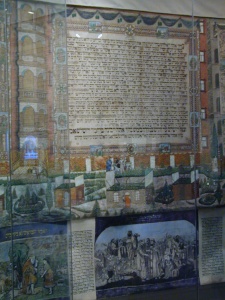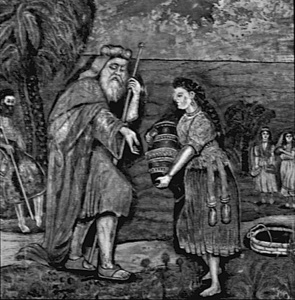At The Museum of Jewish Heritage
The Shelter from the Storm

The Museum of Jewish Heritage, located at the southern edge of Battery Park City in Manhattan, attempts (and largely succeeds) to make sense of the last century of Jewish life. The first floor, “Jewish Life a Century Ago”; presents the diverse and extensive Jewish world in Europe prior to the Holocaust. The second floor exhibition of “The War Against the Jews” depicts the unprecedented storm that swept that Jewish world by the Nazis and their cohorts. Finally, the third floor documents “Jewish Renewal”; the revitalization of the Jewish world, predominately in the United States and in Israel. Unfortunately, the museum fails to adequately explore the extensive yeshiva world, its destruction and stunning post-war renewal; the complex development of the State of Israel in light of the Holocaust, and the vibrant rebirth of a Jewish world in parts of Europe and Russia. But what it does focus on, i.e. a broad view of Jewish life, it succeeds admirably.

One must move through this museum slowly and thoughtfully. The presentations are done using three major elements; 1) Objects that document this history; 2) Text that describes events; and 3) Video presentations that either illustrate history or present personal video testimonies. The personal video testimonies are clearly most powerful because only they can transform a history into living memories that we can now share. To ignore any one of these elements is to miss the depth and complexity of the Museum’s message. The Museum has an extremely diverse audience of Jews and non-Jews with many different levels of knowledge. Therefore, it starts with an 8 ½ minute slide and video presentation to present the Jewish People to this audience. Next one enters “Jewish Life a Century Ago”, a primer of Jewish ritual and life. The centerpiece of this primer on the first floor is the museum’s masterpiece of Jewish art, the Steinberger Succah.
Aryeh Steinberger, born in 1859 in Olaszliszka, Hungry, and was a cantor and shochet in Budapest. In 1924 he retired to devote himself to his art work. Over the next decade he made these hand painted succah panels on canvas which expresses a complete and moving vision of the fully integrated Jewish world he lived and loved. He continually added to these paintings over the years. This succah was used until his death in 1942 at age 83. It was hidden during the Nazi occupation of Hungary in the basement of the Great Synagogue on Dohany Street (pictured in the Succah itself) until after liberation.
The upper seven panels guides us as we lift our eyes to make our brochos pertaining to Succah, including the ‘Kavana’ and brochos before taking the Four Species, Benching, Ushpizin, Yom Tov and Shabbos Kiddush, Havdalah, etc. They are all wonderfully lettered, surrounded by sumptuous border panels with local landscapes, floral and decorative motifs, all made to look like rich hanging tapestries.
A narrow street with an ornate fence and many gates runs as border between the upper and middle registers. Between the seven upper panels you see five fantastic towers (perhaps entrances to local apartment buildings) while along the street there are ox carts and cattle along with ordinary people strolling or peering through the elaborate fence.
The middle register depicts local Budapest backyards and gardens dotted with 10 family succahs. Yom Tov is everywhere. Further along Steinberger depicts, his own family going to shul on Succos and extensive Hungarian landscapes and towns. Then the subjects become biblical with Abraham Greeting the Three Strangers, The Stolen Blessing of Isaac, Moses and the Law, The Mishkan in the Wilderness, Joseph Greeting his Brothers and finally King David Playing the Harp. With over 70 painted figures, the diversity of subjects and their depiction in these panels are truly splendid. Steinberger manages to blend the biblical with the contemporary scenes in a way that fully expresses the fullness of a religious Jew’s life in Budapest in the 1930’s. And most significantly, he makes us feel welcome in this world.

The lowest register, which acts like a foundation for the whole succah, contains eight narrative panels interspersed with entire Mishnah Succah meticulously hand lettered. The 18” x 24” painted panels are a masterful meditation on faith, kindness and our contemporary lives as seen through biblical narratives and yearly rituals. The highly personal choice of the following subjects reveals that Steinberger was a complex and profound artist. We see Daniel in the Lion’s Den, Abram and Lot Separating, Rebecca Offering Eliezer Water, the First Seder in Egypt with His Family Fully Prepared to Go, Hoshannas Around the Bimah, Blowing the Shofar at Rosh Hashana in Shul, Kaporos with Chickens Erev Yom Kippur, and Complete Prostration during the Yom Kippur service. Many of these motifs are unique in their depiction in Jewish art.

The very personal nature of his paintings reflects the stories we see and hear again and again in seemingly live video reflections on the two floors of the museum above.
This wonderful painted succah is a metaphor for our reflections on the terror of the Holocaust and the inspiring life the Jewish people have made since. Yearly we move ourselves into a temporary dwelling to contemplate our lives and our relationship with God. What should surround us is, as in the Steinberger Succah, our Torah, our traditions, and our life in the contemporary world. This shelter of faith, kindness and community allows us to persevere over our enemies and build a more vibrant and stronger Jewish world in the year to come. We have remembered who we are and why we are here. The injunction, Zahor, Remember…Never forget, is fulfilled.
MUSEUM OF JEWISH HERITAGE
18 First Place, Battery Park City, NY, NY